Monastery of Santa Catalina de Siena, Arequipa
The Monastery of Santa Catalina de Siena is a monastery of nuns of the Dominican Second Order, located in Arequipa, Peru.
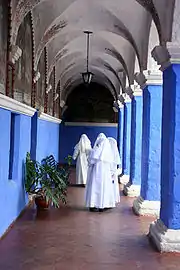
History
The foundress of the monastery was a rich widow, Maria de Guzman. The tradition of the time indicated that the second son or daughter of a family would enter a life of service in the Church, and the monastery accepted only women from upper class Spanish families. Each family paid a dowry at their daughter's admission to the monastery. The dowry expected of a woman who wished to enter as a choir nun—indicated by wearing a black veil—and who thereby accepted the duty of the daily recitation of the Divine Office, was 2,400 silver coins, equivalent to about $150,000 (U.S.) today. The nuns were also required to bring 25 listed items, including a statue, a painting, a lamp and clothes. The wealthiest nuns may have brought fine English china and silk curtains and rugs. Although it was possible for poorer nuns to enter the convent without paying a dowry, it can be seen from the cells that most of the nuns were very wealthy.
In 1871, Sister Josefa Cadena, O.P., a strict Dominican nun, was sent by Pope Pius IX to reform the monastery. She sent the rich dowries back to Europe, and freed all the servants and slaves, giving them the choice of either remaining as nuns or leaving. In addition to the stories of outrageous wealth, there are tales of nuns becoming pregnant, and amazingly of the skeleton of a baby being discovered encased in a wall. This, in fact, did not happen in Santa Catalina, and there are rumors of the same story in the nearby Santa Rosa monastery, as well.
At its height, the monastery housed approximately 450 people (about a third of them nuns and the rest servants) in a cloistered community. In the 1960s, it was struck twice by earthquakes, severely damaging the structures, and forcing the nuns to build new accommodation next door. It was then restored in stages by groups including Promociones Turisticas del Sur S.A. and World Monuments Fund and opened to the public. This also helped pay for the installation of electricity and running water, as required by law.
Gallery
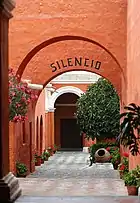 One of the many alleys within the monastery.
One of the many alleys within the monastery.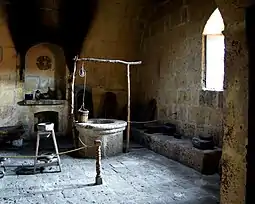 A restored historical kitchen in the monastery.
A restored historical kitchen in the monastery. Convent of Santa Catalina.
Convent of Santa Catalina. Santa Catalina Monastery.
Santa Catalina Monastery.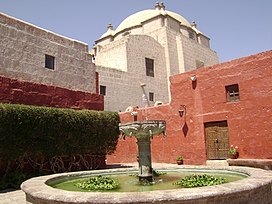 Fountain at the Convent of Santa Catalina.
Fountain at the Convent of Santa Catalina. White street with roses in the monastery
White street with roses in the monastery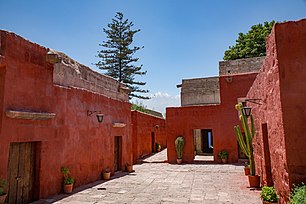 Red street in the monastery
Red street in the monastery
In culture
The Santa Catalina monastery features in some detail in the second half of The Book of Human Skin by Michele Lovric.
Patrick Leigh Fermor visited the monastery on 27 August 1971, and wrote of his impressions in the third of his Three Letters from the Andes (1991).
Sources
- Lonely Planet Peru (2004). Charlotte Beech and Rob Rachowiecki. Lonely Planet Publications. ISBN 1-74059-209-3
- About.com South America for Visitors article
External links
| Wikimedia Commons has media related to Santa Catalina Monastery, Arequipa. |
- Santa Catalina Official Site (Spanish & English)
- Photos of Santa Catalina Monastery (English)